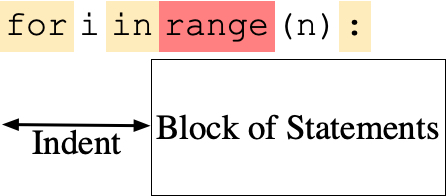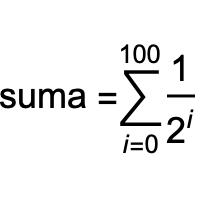Repetition of Statements
As we have seen when looking at Algorithms such as Heron's (a.k.a. Hero's, a.k.a Babylonian Algorithm) to calculate a square root, in programming we have ample reasons to repeat the same (or slightly altered) group of statements (known as a "block"). Python implements two constructs: the more specialized for-loop and the more general while-loop, which we are going to meet soon.

The for-loop in Python has an iteration variable. An example is given in the
picture above. The first line for i in range(n): consists of the key-word
"for", followed by the i. The range(n)
in this example will generate all of the integer values starting with 0
and terminating with n-1. For each of these values, the statements in
the block are executed.
Python is different from the for-loop in C, C++, or Java, in that for loops are more general. For example, if we want to print out the letters of some user input on separate lines, we can use:

Here, the for loop causes all the letters of the input to become successively
stored in the variable letter, which in the body of the for-loop,
the indented statement, are then printed out.
The range keyword
The range keyword generates a sequence of numbers. The range construct is quite
flexible. If there is a single parameter such as in range(7), then the
range generates the numbers starting with 0 (this is a peculiarity in all of Computer
Science that we start counting with 0) and finishing with 6, i.e. it generates 0, 1,
2, 3, 4, 5, 6. We stop with 6 because we generated 7 numbers. Thus, the parameter
is called the stop value. If there are two parameters to range as in range(5,9)
, then we generate 5, 6, 7, 8. Thus, the first parameter is the start value
and the second parameter becomes the stop value. Finally, we can also specify a stride,
that would be the third argument to range. For example, range(5, 14, 3)
, the first value is still the start value, namely 5. But the second value is
5+3 = 8, since the stride is 3. We stop before the sequence reaches 14 or a higher number.
Thus range(5, 14, 3) generates 5, 8, 11 and then stops because the next
value would be 14. The stride can be negative, in which case the sequence goes
backward. We still start with the start value, but stop just before the sequence reaches
the stop value or below. Thus range(25, 14, -3) generates 25, 22, 19, and
16.
Calculating sums and products
A frequent pattern in this class is the calculation of sums of products. For example, let's calculate the following sum:

We notice that the index goes from 0 to 100, therefore the start value is 0 and the stop value is 101, not 100, because we want to include 100. We need to also have a variable to accomodate the partial sum; this is called an accumulator. This results in the code below, where I also print out the partial values of the accumulator.

Notice the use of the iteration variable i, how its range is being defined,
and that the accumulator accu is initialized to zero and augmented
throughout the loop. If you run the code, you will see that the accumulator quickly
becomes 2.0, which is not quite the exact value, it should be 1/2**100
less, but floating point arithmetic is never exact. If the taks is to calculate a
product, then the accumulator needs to be initialized to 1. If it were initialized
to zero, then it would stay zero, whatever we multiply with it.
